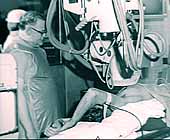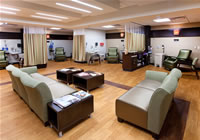|
Angioplasty from the
Wrist: Help for Patients and Physicians
|
 |
March 25, 2010 -- The transradial
or wrist approach to catheter-based heart procedures, such as diagnostic
catheterization, angioplasty and stent placement, has less bleeding
complications, is less expensive and is much preferred by patients.
Yet it is practiced in only 3-5% of cases in the United States;
it is far
more prevalent
in
Europe
and around the world. But burgeoning interest in the technique from
U.S. interventional cardiologists is creating a demand for more training
and informational tools.

Sunil V. Rao,
MD |
|
Sunil V. Rao, MD, FACC, FSCAI,
Assistant Professor of Medicine, Duke University Medical Center,
and Director, Cardiac Catheterization Laboratories, Durham
VA Medical Center has been a strong proponent of the transradial
approach. He states,
"There
is definitely a huge demand for transradial education in
the U.S.,
greater
than we
have seen in the past. There
are both clinical and economic factors driving transradial
interest, but the demand is outstripping the availability
of educational
options."
|
Growing Interest in
Transradial
Recent evidence
of this increasing demand for information
was seen at the September TCT meeting in San
Francisco,
when a five-hour seminar on the transradial approach overflowed
into the hallway and a second conference room had
to be opened to accommodate the hundreds of cardiologists eager
to learn about this technique from the panel of experts. An
evening symposium at the same meeting was also packed, much to the
delight of the event's sponsor, Terumo
Interventional Systems, a company that has been
actively promoting the spread of transradial access.
|
|
 |

Dr. Melvin
Judkins in cath lab |
|
Femoral Approach is 50 Years
Old
In the U.S., most catheter-based cardiac procedures are done
through a small incision in the femoral or groin artery. When
the femoral approach was first developed by Dr. Melvin Judkins
in the 1960's, it was rapidly adopted as being much preferable
to the semi-surgical brachial technique: it was easier, quicker
and had less complications.
Now, almost half-a-century later,
the Judkins or femoral technique has proven to be very durable:
it has barely changed and is still the mainstay
of interventional cardiology. |
Transradial Offers Advantages
However, with the
growing use of powerful anticoagulation drugs for stenting, as well
as the
significant
increase in heavier patients (more difficult to compress the artery
post-procedure and achieve hemostasis)
concern over bleeding complications has become a major topic of
discussion among cardiologists. Additionally, a number of recent
studies have associated bleeding
complications with increased mortality and morbidity.
The transradial technique lowers bleeding complications
to almost 0% and allows a patient to stand up and walk almost immediately.
So why isn't it used more? One reason is that
most cardiologists aren't
exposed to it in their training fellowships. Only a limited
number of teaching institutions use the approach, so only the
cardiologists who train there learn it. Once established, an interventional
cardiologist
must take time off from his or her
practice to train and, as Dr. Rao has stated, these
training opportunities
are not keeping pace with the current demand.
Training Aids for Professionals
To aid in this training
process, Terumo Interventional Systems yesterday announced the
launch
of a new
web site
for
healthcare professionals,
www.transradialuniversity.com,
which contains on-demand informational
modules intended to provide physicians with an introduction to various
aspects of transradial cases from arterial access through hemostasis,
including tips and tricks, with contributions from leading transradialists.
In addition, Angioplasty.Org recently launched
a listing of Transradial
Training Courses in its Radial
Access Center. Most of these courses are
one or two day meetings where
interventional cardiologists, nurses and technicians can get instruction,
sometimes
with simulators,
sometimes scrubbed in on actual cases. Any hospital that is offering
a transradial program can also submit
the information for a free
listing.
Help for Patients
Most patients are not aware that there may be a choice between two different
approaches. They are given a prescription to get an angiogram and they usually
are not asked a preference. But in an institution where cardiologists practice
the wrist approach, they will. And they invariably choose the wrist over the
femoral -- lower complications, instantly being able to walk instead of lying
flat for hours and a general sense of feeling better immediately after the
procedure, instead of having to be cautious about lifting things, exerting
oneself, etc. Cardiologists who practice the radial approach have reported
that patients seek them out. To expedite this process, Angioplasty.Org has
posted a Radial
Hospital Locator where patients can browse hospital centers by
state in order to find one that offers radial. This listing is growing
with hospitals and cardiology practices being added weekly. |
|

"Radial
Lounge" at St. Joseph's Hospital
in Atlanta where patients
go after an
angioplasty: no beds, just chairs,
wireless internet,
wide screen TV
and
more (photo by Chris Savas) |
Growth Seen for the Future of Transradial
As more and more hospital centers begin offering the wrist approach,
an increasing number of cardiologists-in-training will be exposed
to it. Most interventionalists who have adopted the approach report
using it in 50-90% of all cases with great success. Manufacturers
of catheters and hemostasis devices specifically for the radial
approach are constantly refining the equipment, making the technique
easier, safer and faster. As word spreads, patients will be driving
the adoption of a technique that makes their experience much better.
And finally, the pressure on reigning in healthcare costs will
come into play: the radial approach offers the possibility of
safe and effective angioplasty on an outpatient basis. Several
studies are now in process documenting these factors and measuring
the cost-effectiveness of the transradial approach.
About The Radial Access Center on Angioplasty.Org
To assist in educating the professional and patient population
in the U.S. about the this technique, Angioplasty.Org has created
the "Radial
Access Center for Transradial Approach", a special section
devoted to information and news about the transradial technique, for both
patients
and physicians. The Radial Center features interviews with leading practitioners
of the radial technique, such as Drs. Jeffrey Popma, Sunil Rao, John
Coppola, Shigeru Saito, Jennifer Tremmel and Howard Cohen.
For patients there is also a "Hospital
Locator" that lists U.S. centers practicing radial angiography.
As Dr. Howard Cohen of Lenox Hill Hospital in New York says of
the wrist technique, "Patients really prefer it. 95% of
people who've had it both ways would say 'I'm coming back to
you, Dr. Cohen because I like this transradial a lot better than
the other way!'
Reported by Burt Cohen, March 25, 2010
|




